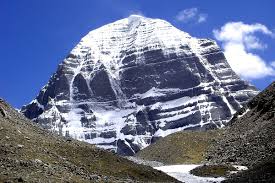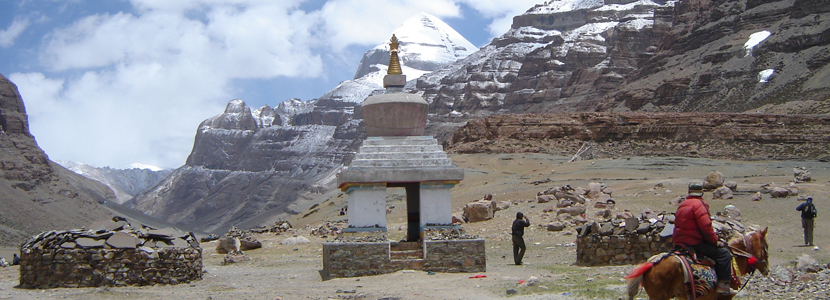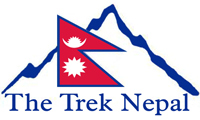Kailash Mansarovar is regarded as one of the most sacred pilgrimages in various religions such as Hinduism, Buddhism, and Jainism. Mt. Kailash is considered one of the holy mountains as it is recognized as the residence of Lord Shiva, along with goddess Parvati and their two children, lord Ganesha and Lord Kartikeya.

Mt Kailash is considered one of the holiest summits, but it has never been summited by any climbers. Although many of the climbers tried to summit the mountain but it is failed by everyone. Mt Kailash is the spiritual center of the cosmos.
Mansarovar Lake is one of the highest freshwater lakes in the world at an altitude of 4590m(15060 ft). Bathing in Mansarovar Lake or drinking water from Mansarovar Lake is considered to wash out sins and provide liberation as per Hinduism and Hindu mythology.
Overview of Trip
You will get a tour of Mt. Kailash and Mansarovar Lake along with various UNESCO World Heritage sites residing in Nepal. To reach Mansarovar and Mt. Kailash, crossing the border to Tibet is required. You will be accompanied for 14 days along with our Tour crew and Tour Guides.
This spiritual journey promises a transformative experience amid mythology, tradition, cultures, and breathtaking landscapes.
- Holy Mount Kailash and Lake Mansarovar
- UNESCO World Heritage Sites
- Sightseeing in Nepal & Tibet
- Three Days Parikrama (kora) around Mt. Kailash
- Dolma La Pass – 5650m
- Exploration of Tibet and the nomadic lifestyle
Highlights of Kailash Mansarovar Yatra
- Experience the power of religion during the Kora trek around Kailash Mansarovar
- Interact with the pilgrims around the Yatra and understand their religious values
- Visit different monasteries around the area, namely Chuku monastery, Drirapuk monastery, Zultripuk monastery, Selung monastery, and Gyangzha monastery
- Never miss the Kailash Saga Dawa Festival
- View the natural beauty and aura of Kangkyam glacier
- Following the completion, enjoy yourself in the Tirthapuri natural hot springs
Cost of Kailash Mansarovar Yatra and Tibet Tour
The cost of Kailash Mansarovar is hard to predict without knowing the actual requirements. Most of the time, the cost tends to vary based on tour length, options you choose, along the time of the year.
It is evident to say that the Kailash Mansarovar trip isn’t a cheap one, and you need proper time and focus. However, with The Trek Nepal, you will be able to arrange the overall trip at an affordable price.
As the overall tour is done in large parts of Tibet, the cost generally remains on the higher side.
The cost of a Kailash Manasarovar Yatra varies depending on the tour length, options you choose, and time of year. It is not a cheap trip, but it is an affordable one. Interestingly, the accomodation in the area is also of the highest order, resulting in expensive pricing.
Weather During Kailash Mansarovar Yatra and Tibet Tour
The Tibet region is known to be a cold region. All around the year, the weather remains manageable and on the lower side. Most of the time, you will see people wearing layered clothes. As a result of that Kailash Mansarovar trip is more or less in the colder region.
Interestingly, spring and autumn are the best seasons to perform the trek. Anyone willing to do the trip during winter will have to face weather below -30 degrees Celsius, which is hard in itself. Being in the high elevation area, righ weather means that you will see beautiful sunshine from the high elevation area.
Difficulty of Kailash Mansarovar Yatra
Kailash Mansarovar trek is difficult. Placed at the maximum altitude of 5630m, this trek demands your skills and dedication. You will need to be physically fit to complete the trek.
The Trek Nepal would like to suggest that you have some prior training before coming on this trek. The major reason is the icy conditions that remain all year. With uneven paths, you might also find loose rocks along the way, which makes the overall experience hard.
Most of the things required for the trek will have to be carried by oneself, which could also be challenging. Even with so much of challenges, you can perform the Kailash Mansarovar and Tibet trek with proper assistance from The Trek Nepal.
But before booking for the trip, get a physical checkup and also work on cardiovascular, strength, and flexibility exercises. All of this will only make your experience befitting and easier.
When is the Best Time for Kailash Manasarovar Yatra?
Most of the treks around the world are better when performed during the autumn or spring season. These are the periods when the sun is shining better, the roads look cleaner, and the air looks fresher.
In the case of the Kailash Mansarovar and Tibet trip, April to June and September to October are the best times. There is a very low chance of rain, and you will find awesome scenery and visibility.
Eventhough the daytime temperature is warm, the nights are cold, which makes for a brilliant experience. Some of the enthusiasts perform the trip during July and August, but there is a chance of rain.
Ignoring all the weather and conditions, if you are religious, try and place the trip during the Saga Dawa festival. It takes place during the 4th month of the Tibetan calendar, and it is also the most auspicious occasion to visit Mount Kailash. Most of the time, this period comes in May.
Permits Required For Kailash Mansarovar Yatra and Tibet Tour
Trekking to the well-known places requires a permit, and the same is the case with the Kailash Mansarovar trek. You will need to get permits from the Tibetan tourism board for the trip.
All in all, the permits required for Kailash Mansarovar Yatra and Tibet Tour are:
- Tibet Travel Permit
- Alien’s Travel Permit to visit Shigatse, Nyingchi, and Mount Kailash.
- Military Area Entry Permit
- Foreign Affairs Permit
Food During Kailash Mansarovar Yatra and Tibet Tour
All the tourists and trekkers will be provided with high-quality food during their stay in the Kailash Mansarovar Yatra and Tibet tour. Having said there will be a variety of meals that will be presented to you.
Starting out, there will be 3 meals in the day with breakfast, lunch, and dinner being the focus. Along with that, we also focus on tasty and healthy food that is full of nutrients that will be useful during the yatra.
Being on the religious tour, the food will mostly be vegetarian. However, all the food will be of the highest quality. From early morning breakfast of tea, coffee, butter, toast to Pulao, Chana Alu, Veg Biryani, Paratha, you will have options to choose from.
Accomodation During Mansarovar Yatra and Tibet Tour
Kailash Mansarovar yatra takes place in one of the highest altitudes. Being a remote area with limited facilities, you will have to adjust to guesthouses. For the first night, the stay will be at Drirapuk monastery, with the second night being Zutulpuk monastery.

There are dormitory-style beds and rooms, which will be shared. There are a few shared room options too, but the cost will be on the higher side if you choose that.
Based on the cold weather, AC won’t be provided to the guests, but you will be given the warmest blankets to keep you safer. In order to get the blessings of Mount Kailash, you might have to adjust a bit.
Detailed Itinerary About Kailash Mansarovar Yatra and Tibet Tour
Day 01: Arrival in Kathmandu
You will be provided pickup services at TIA by our representatives and will be guided to the hotel where you’ll be placed. Briefing sessions regarding the trip and the days to be spent during the round-trip to Kailash Mansarovar. Also, you will be introduced to our members, staff, and guides for the trip.
Day 02: Sightseeing in Kathmandu
On the second day, we’ll take a tour of a few well-known Hindu temples in the Kathmandu Valley. We will visit the Pashupatinath, Guheshwari Shaktipeeth, and Jalnarayan Temple. Later, you can get some supplies for the Yatra if necessary. Overnight at a hotel in Kathmandu.
Day 03: Kathmandu to Syabrubesi
On the third day, we’re going to drive to Syabrubesi in the morning. The settlement of Syabrubesi is located in Langtang, in Kathmandu’s northern area. We arrive in Syabrubesi after a 6–7-hour drive through the Pasang Lhamu Highway. Spend the night at a guest house.
Day 04: Syabrubesi to Kerung
Following breakfast on the fourth day, we will set out for the Rasuwagadhi-Kerung border or the friendship bridge at the Nepal-Tibet border. In about four hours, we will reach Kerung (also known as Gyirung), the first village in Tibet. Rest at the guesthouse.
Day 05: Kerung to Saga
On the fifth day, the route takes us smoothly to the settlement of Saga by ascending and descending the passes of Thong La and La Lung. We will be able to witness Lake Peiku Tso and the Tibetans’ customary method of yak and sheep grazing along the way. Hotel overnight stay.
Day 06: Acclimatization at Saga
On the sixth day, we will spend the day in Saga County to acclimatize to the altitude. There are options to go on short hikes and roam around the Saga throughout the day. Overnight at a hotel in Saga.
Day 07: Saga to Mansarovar via Paryang
After our breakfast at Saga, on the seventh day, we will be driving to the highest freshwater lake in the world, the holy Mansarovar Lake, lying at an altitude of 4558 meters, stretching wide with a pristine greenish-blue color. The holy lake is believed to be the resting place of Lord Bishnu. It is surrounded by Mt. Kailash, Mt. Gurula-Mandata, and the Lake Rakshasha (Rakshash Taal). The Rakshash Taal is believed to have been created by the Evil King Ravan, and the locals believe the water is poisonous. Overnight at the guest house around Lake Mansarovar.
Day 08: Mansarovar Exploration – drive to Darchen
On the eighth day, we will get into our spiritual selves and perform some rituals (puja) at the bank of the holy lake Mansarovar. Our staff will provide a bucket of hot holy water for each yatri from Lake Mansarovar for bathing. After our puja and prayers, we will complete the Parikrama of the Mansarovar Lake on a Jeep, and continue to the base camp of Kailash, Darchen. It is a village town right in front of the sacred Mt. Kailash. Overnight at the hotel.
Day 09: Darchen – Yamadwar – Drirapuk (Kora starts)
On the tenth day, we will embark on a three–day parikrama. We first drive to the small settlement of Tarboche, also called Darboche. It is the starting point of the Kailash Kora, and is also known as the Valley of Gods. Yamadwar, the gateway of the God of Death, is located here in Tarboche. We will walk for a few hours to arrive at the settlement of Derapuk, settling right in front of the North Face of Mt. Kailash. Overnight and rest at a guest house.
Day 10: Dirapuk to Juthulpuk (Drolma La Pass)
Among the three days of Kora, it is the longest and the most difficult day. We will be heading towards the village of Jarok Donkhang first, and hike towards the Shiva-stal. We will rest for some time, take a steep downhill, and get to the banks of Lham-chu Khir river. We catch sight of the Holy Pond of ‘Gaurikunda’. We reach the village of Juthulpuk, this place is named after. The famous cave of Juthulpuk, Zruthulpuk cave, also known as ‘the miracle cave’. We will also catch sight of the Buddha’s Footprints along the way. Overnight at a guest house.
Day 11: Juthulpuk to Saga (Kora Ends)
On the eleventh day, we will spend the morning touring the nearby Milarepa cave’s caves and temples. After breakfast, we will climb for three to four hours to finish our Kora and return to the Darchen settlement. We’ll eat there for lunch before heading back to Saga. Hotel overnight stay.
Day 12: Saga to Kerung
On the twelfth day, we will take a nice ride on paved Tibetan roads back to the settlement of Kerung, which is at the border between Nepal and Tibet. Today is our day off, so we may relax and spend the night at a guesthouse in Kerung.
Day 13: Kerung to Kathmandu
After completing the immigration procedures at the Nepal-Tibet border, we will drive back to Nepal’s capital, Kathmandu. Afternoon souvenir shopping and overnight at the hotel.
Day 14: Departure for the home country
This is the final and toughest day of the tour. After visiting the religious places and enjoying the beauty of Tibet, we will be heading home on the 14th day. One of our representatives will drop you off at the airport where you will be heading home.
Trip Cost Inclusions
Eventhough you will be paying for the trip, there arent everything that gets included in the cost. Some of the major inclusions during the trip include:
Documentation
- Tibet Permits
- Tibet Visas
- Special Kailash Mansarovar Permit
- Applicable Entrance Fees to the above-mentioned places
Transportation
- All ground transportation is in private vehicles
- Airport Pickup and Drop Off Service
Trip Cost Exclusions
Apart from all the aspects that are included in the cost, some factors are overlooked or excluded from the cost. These include
- Personal Expenses
- Pony – Horseman – Helper
- International Airfare
- Insurance
- Emergency Circumstances
- Extra Nights
